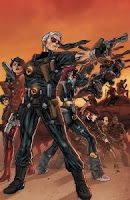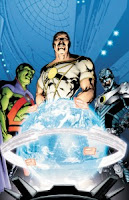 A follow-up today to my post on superhero RPG ideas from DC’s relaunch yesterday. Eisner-award winning artist and illustrator for Flashpoint Project Superman* Gene Ha added a comment to my post yesterday. He brought up a couple of interesting ideas. I’ve been thinking about setting generally, and superhero settings in particular- which is a post I want to come back to. But Gene’s forced my hand, so I thought I could probably get a 1000 words out of a response. I’ll also point to a post on this topic from Dice Monkey.
A follow-up today to my post on superhero RPG ideas from DC’s relaunch yesterday. Eisner-award winning artist and illustrator for Flashpoint Project Superman* Gene Ha added a comment to my post yesterday. He brought up a couple of interesting ideas. I’ve been thinking about setting generally, and superhero settings in particular- which is a post I want to come back to. But Gene’s forced my hand, so I thought I could probably get a 1000 words out of a response. I’ll also point to a post on this topic from Dice Monkey.*Yes, I’m going to keep banging that drum.
Gene writes:
Two things I'm really curious to hear your take on. Most obviously, what do you think of setting a superhero RPG campaign in a "reboot" of a classic superhero universe. Some sort of "Crisis" event would be part of the public record (eg red skies, superhero battles, etc) but people wouldn't understand that history had been changed. In a sense, I think this is what the current World of Darkness setting is. You'd be free to change anything. In the DC Relaunch, the Enchantress is pure evil. Obviously, change secret identities. Superman was never adopted by the Clarks. Second, buy in being helped by using an established universe. Using the DC Relaunch model, I think you can get great effect from a superhero world that's only a few years old. The most powerful team is only a few years old. Most heroes and almost all supervillains aren't known to the public yet. In my one session 'campaign' this worked very well.GM Knowledge
I’m going to address those two questions separately, but I have to set up a couple of things. I’m a DC guy- I mean I love the Marvel Universe, the Byrne/Claremont run shaped my thinking about superheroes. But before that I was reading DC, Batman, Superman, the Flash, Aquaman, and especially the JSA. I watched every season of the Super-Friends religiously. I was buying heavily before Crisis on Infinite Earths and after that for several years, through Millennium, through Invasion, and so on. I dropped off a lot in the 1990s, so I missed things like Zero Hour and Bloodlines. Eventually I came back and figured out where everything was continuity-wise, going back to read classics I’d missed, like Starman and new great things like Seven Soldiers. So I’d consider myself pretty knowledgeable about the DC Universe. And with certain exceptions, the Marvel Universe, because I like to read reviews and summaries.
 Player Knowledge
Player KnowledgeBut I’m the exception among our group. I have a little over a dozen active gamers spread out among the five rpg campaigns. If we extend that out a little further, we can add another dozen gamers who have I have played with, play with infrequently, or talk to about gaming. So let’s put that number at about two dozen. Of the first group, I’d venture to say none of them really know current continuity in Marvel or DC. A couple might know a little more about Marvel, and have something of a handle on that. Among the larger group, we add a couple who do know comics continuity, usually for one line or the other. Only one person I would expect to know it well, and to know the events and characters of other lines (like Image or Wildstorm).
What do players know? I think they know the main characters as presented in the movies: Batman, Superman and now Green Lantern. They might have some other familiarity from other media: Robin, Wonder Woman, Teen Titans, etc. But I bet that be a kind of pastiche. They might have watched Superman, Batman Adventures, Teen Titans or even The Batman. But I bet they don’t know Justice League Unlimited or The Brave and the Bold. So one thing I think is that you have to play to the player’s level of knowledge.
 Rebooting Your DCU
Rebooting Your DCUWhich brings me to Gene’s first idea (and which Dice Monkey also suggests): doing an event which changes the continuity of an existing universe. Ideally it would allow you to reset things, but the problem is that you’re likely referencing things which the players aren’t aware of in the first place. In that case, you don’t really need and event to have that come around. You can just run the game with, let’s say a DC continuity, but you’re still going to have to spell it all out for the players. They don’t know all the references: how Elongated Man is a great detective, that Captain Atom is a kind of time-traveler, that there have been several incarnations of the Vigilante, that the Spider is a legacy hero and so on. I think you could only reasonably work with the big characters of the DC universe, and their changes. That’s where the Justice League cartoon really works for me. It begins with a small, tight group and builds continuity from there. You get many episodes before other significant elements of the DC universe get established.
I have two competing criteria for game concepts there days: 1) what does it add to the game? and 2) how much work does it involve? You could have some of those big DC characters, revised, in the background, but I don’t think it necessarily establishes a structure of tone for the players. Unless you establish that the PC are peers to those characters, in which case you could use that as a means of providing affirmation to the players. Otherwise you might be stuck in the same mode as the DC Universe Online game, where the archetype characters just serve as waypoints and mentors.
 Gamers' Rosetta Stone?
Gamers' Rosetta Stone?But I think one way to get around this would be to find some easily read and comprehensive Urtexts for the players. For example, when I went to run my Star Wars game, I said the only things canon were those which appeared in the films. Everything else- books, games, comics, etc,- the players couldn’t count on. They might appear, but no assumptions should or could be made from that. I could have been even narrower and said only the New Hope trilogy, which would have required them to actively ignore a bunch of things they’d seen. On the other hand, that could be an interesting approach. But generally you want to avoid the kind of hesitation players have about historical games: that they have to know a bunch about the setting to play.
So the question would be what could serve as an Urtext for a version DC Universe. One choice would be Alex Ross’ Justice miniseries. That’s about a close as I can imagine to an easier to grasp version of the setting, though not really in continuity. Beyond that I have trouble picturing comics which give a solid overview of the current DC continuity. Even the new relaunch books don’t have anything like that. Since it isn’t functioning like an Ultimate Universe, there really isn’t that much in the way of simplification. If we look beyond print comics, then we have some great options. People have been talking up Brave & the Bold as a great entry point series, but I haven’t yet caught any of that. What I do know is Justice League, probably my favorite superhero cartoon. You could use just the first season or two as the basis, telling players that’s the background. Then you could later bring in elements from the later Justice League Unlimited series. Except for the glaring absence of Power Girl, that would be great.
On the other hand, another option would be to take a different approach for DC continuity, offering players an easier text to work from. You could build a campaign world from Kingdom Come or New Frontier. These would be striking games, with very different tones. Players would know that only what’s in those books would count for continuity. The nice thing about both of those is that they leave plenty of room for other characters to enter and have an effect on the world. I love the Astro City universe, and you can gain a clearly grasp of that setting in just a few graphic novels. However, that world’s too packed, too rich. You need space for the players to play in.
 The Power to Create a New Universe
The Power to Create a New UniverseOn the other hand, turning back the clock (or moving it up?) to make a new universe I like. This is a great idea- I love the concept of a Year One or almost Year One universe. Superheroes have only been around for a short time. The world’s still getting used to them. There are a couple of iconic heroes, but none with a nation-spanning effect. I would offer the players a chance to play a Year One version of their favorite character, or they could play a new character. They could them be the first Justice League (or Avengers if you want to do Marvel). You could bring the classic villains for those groups to bear (Starro for the former, Kang for the latter). They wouldn’t have to have any real knowledge of the setting, but could instead build their legends themselves.
We had a low-level Watchmen-style campaign in which a player did an alternate version of Batman. It was tremendous fun; Art did a Year One version of Captain America later in the same campaign. The riffs and the background in that case serve as a resource for the GM, rather than a touchstone anyone has to "get." If the players did decide to all run new characters, then I’d probably opt to drop any existing comic book references entirely. Otherwise as a GM I would run the risk of bringing in things outside of the players knowledge or just putting things in to be cute. The players might feel that they weren’t building a legend, but instead playing in someone else’s story.
I like it- I think I might do that with the next supers campaign. The last several supers campaigns I’ve run have all had their own continuity, their own setting. They didn’t incorporate any elements from DC, Marvel or other comic series. I think in part that came out of my worry that bringing over a little piece invited questions about the implications ("wait, if the Question exists in this world, does Lady Shiva or Richard Dragon? He was trained by both of them. What about Batman?"...and so on). I think most of that’s my own fevered mind- how I would react if I played in a campaign which had bits and pieces of other continuities.
Actually what helped break me out of that was running a supers game for four female players, none of whom really invested in the details of the superhero universes. They’d read comics, X-Men, Ultimate Spiderman, etc. but they didn’t think about the genre or continuity the way I did. Reference went past them- they concentrated on play. In some ways the background didn’t matter to them except where they could interact with it.










